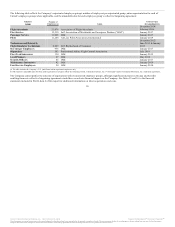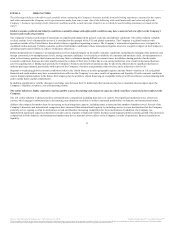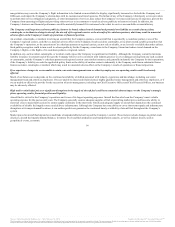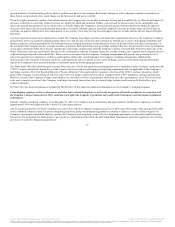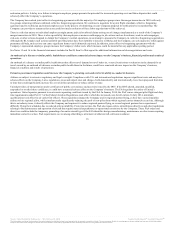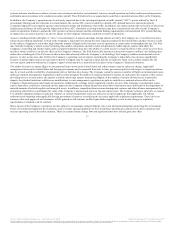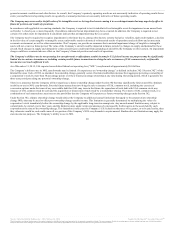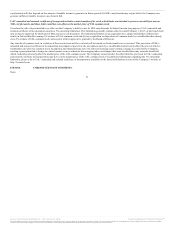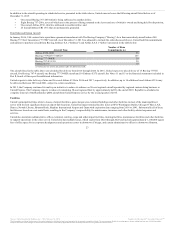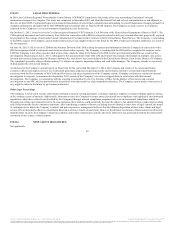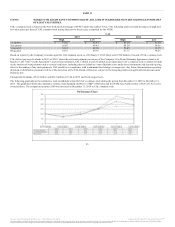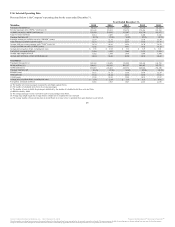United Airlines 2015 Annual Report Download - page 21
Download and view the complete annual report
Please find page 21 of the 2015 United Airlines annual report below. You can navigate through the pages in the report by either clicking on the pages listed below, or by using the keyword search tool below to find specific information within the annual report.
general economic conditions and other factors. As a result, the Company’s quarterly operating results are not necessarily indicative of operating results for an
entire year and historical operating results in a quarterly or annual period are not necessarily indicative of future operating results.
The Company may never realize the full value of its intangible assets or its long-lived assets causing it to record impairments that may negatively affect its
financial position and results of operations.
In accordance with applicable accounting standards, the Company is required to test its indefinite-lived intangible assets for impairment on an annual basis
on October 1 of each year, or more frequently if conditions indicate that an impairment may have occurred. In addition, the Company is required to test
certain of its other assets for impairment if conditions indicate that an impairment may have occurred.
The Company may be required to recognize impairments in the future due to, among other factors, extreme fuel price volatility, tight credit markets, a decline
in the fair value of certain tangible or intangible assets, unfavorable trends in historical or forecasted results of operations and cash flows and an uncertain
economic environment, as well as other uncertainties. The Company can provide no assurance that a material impairment charge of tangible or intangible
assets will not occur in a future period. The value of the Company’s aircraft could be impacted in future periods by changes in supply and demand for these
aircraft. Such changes in supply and demand for certain aircraft types could result from grounding of aircraft by the Company or other carriers. An impairment
charge could have a material adverse effect on the Company’s financial position and results of operations.
The Company’s ability to use its net operating loss carryforwards to offset future taxable income for U.S. federal income tax purposes may be significantly
limited due to various circumstances, including certain possible future transactions involving the sale or issuance of UAL common stock, or if taxable
income does not reach sufficient levels.
As of December 31, 2015, UAL reported consolidated federal net operating loss (“NOL”) carryforwards of approximately $8.0 billion.
The Company’s ability to use its NOL carryforwards may be limited if it experiences an “ownership change” as defined in Section 382 (“Section 382”) of the
Internal Revenue Code of 1986, as amended. An ownership change generally occurs if certain stockholders increase their aggregate percentage ownership of
a corporation’s stock by more than 50 percentage points over their lowest percentage ownership at any time during the testing period, which is generally the
three-year period preceding any potential ownership change.
There is no assurance that the Company will not experience a future ownership change under Section 382 that may significantly limit or possibly eliminate
its ability to use its NOL carryforwards. Potential future transactions involving the sale or issuance of UAL common stock, including the exercise of
conversion options under the terms of any convertible debt that UAL may issue in the future, the repurchase of such debt with UAL common stock, any
issuance of UAL common stock for cash and the acquisition or disposition of such stock by a stockholder owning 5% or more of UAL common stock, or a
combination of such transactions, may increase the possibility that the Company will experience a future ownership change under Section 382.
Under Section 382, a future ownership change would subject the Company to additional annual limitations that apply to the amount of pre-ownership
change NOLs that may be used to offset post-ownership change taxable income. This limitation is generally determined by multiplying the value of a
corporation’s stock immediately before the ownership change by the applicable long-term tax-exempt rate. Any unused annual limitation may, subject to
certain limits, be carried over to later years, and the limitation may under certain circumstances be increased by built-in gains in the assets held by such
corporation at the time of the ownership change. This limitation could cause the Company’s U.S. federal income taxes to be greater, or to be paid earlier, than
they otherwise would be, and could cause all or a portion of the Company’s NOL carryforwards to expire unused. Similar rules and limitations may apply for
state income tax purposes. The Company’s ability to use its NOL
20
Source: United Continental Holdings, Inc., 10-K, February 18, 2016 Powered by Morningstar® Document Research℠
The information contained herein may not be copied, adapted or distributed and is not warranted to be accurate, complete or timely. The user assumes all risks for any damages or losses arising from any use of this information,
except to the extent such damages or losses cannot be limited or excluded by applicable law. Past financial performance is no guarantee of future results.


